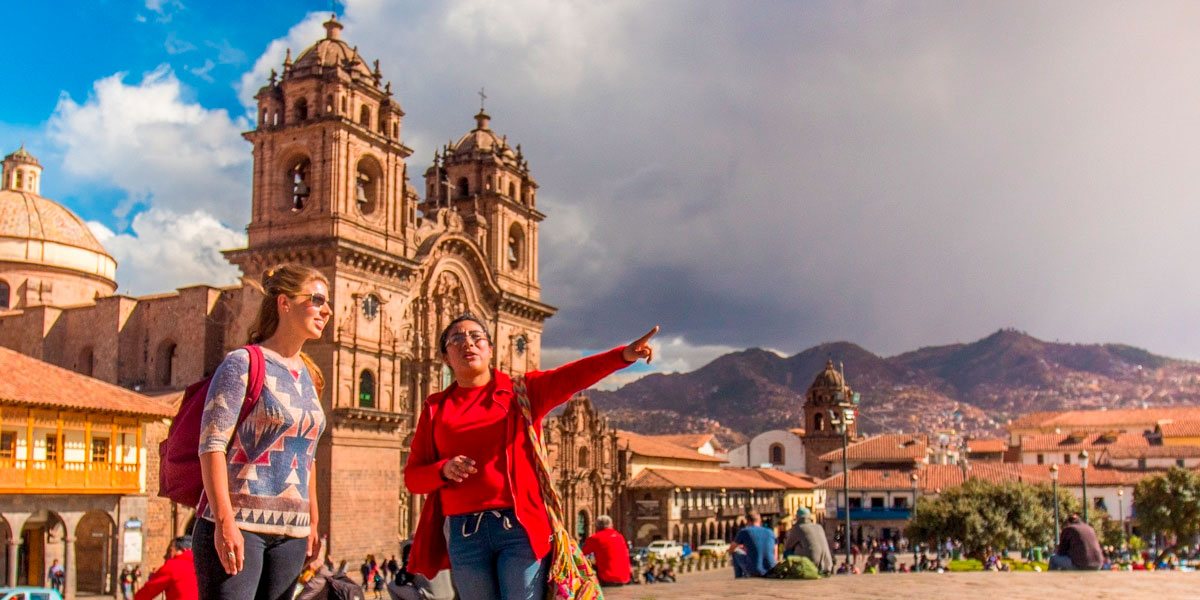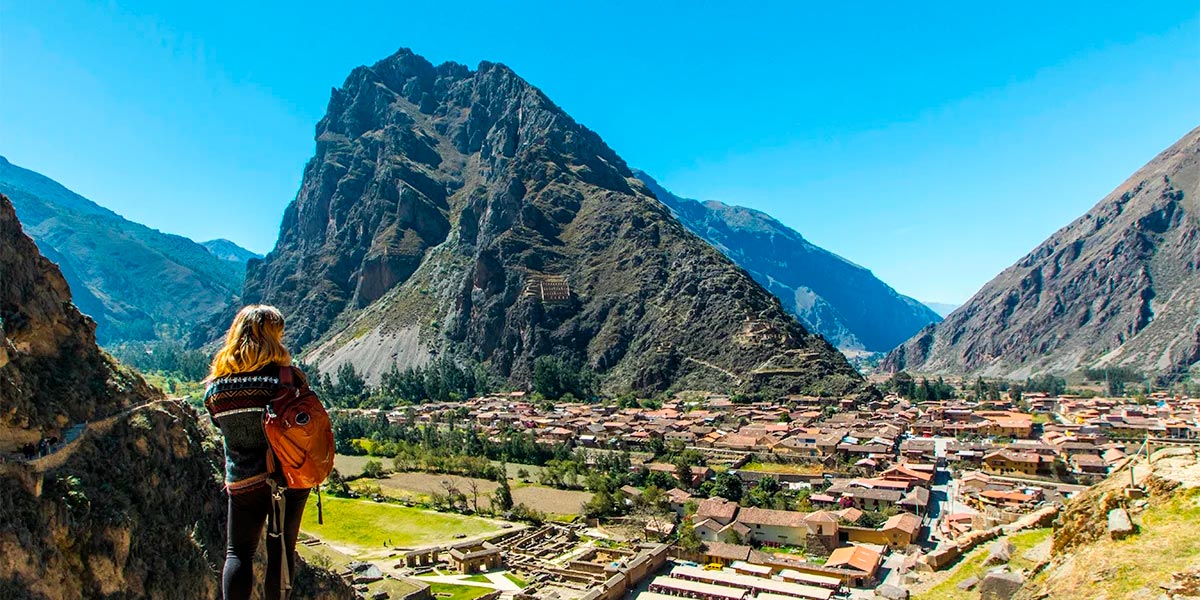Cusco is one of the most visited destinations in Peru and a starting point for exploring the famous Sacred Valley. This ancient capital of the Inca Empire surprises with its cobblestone streets, colonial temples, and ruins that still stand. From here, the main tours depart to the Sacred Valley Peru, a place that combines living history, Andean landscapes, and towns full of tradition.
Furthermore, Cusco and the Sacred Valley are connected both geographically and culturally. Just an hour away, this route takes travelers through mountains, agricultural terraces, and ancient Inca ceremonial centers. In addition to being the natural path to Machu Picchu, the Sacred Valley is ideal for day trips, adventure activities, or tours through communities that still preserve their cultural identity.
Cusco: The Historical Capital of Peru
Cusco was the capital of the Inca Empire and the most important political, religious, and administrative center of the Andes. From here, the Tahuantinsuyo extended, connecting thousands of kilometers of roads to what is now Colombia, Ecuador, Bolivia, Chile, and Argentina. After the arrival of the Spanish in the 16th century, Cusco was transformed into a colonial city without losing its Inca essence, resulting in a unique architectural blend that can still be observed in temples, walls, and streets.
Essential places to visit in the city
- Plaza de Armas - The Plaza de Armas is the heart of Cusco. Here you will find the Cathedral and the Church of the Society of Jesus, as well as restaurants, cafes, and tour agencies. It is a meeting point for travelers and locals, especially during festivities such as Inti Raymi or Corpus Christi.
- Qoricancha - This temple was the most important in the Inca world, dedicated to the Sun god. The perfectly assembled stone walls continue to impress, and on top of them, the Santo Domingo convent was built, which makes the superposition of cultures evident.
- Sacsayhuamán - Located on the outskirts of the city, it is one of the most impressive fortresses of the Inca legacy. Its enormous stone blocks fit precisely without any mortar. In addition to its historical importance, it offers a panoramic view of Cusco.
- San Blas Neighborhood - Known as the artisans' neighborhood, San Blas is ideal for walking through steep streets, visiting art galleries, craft shops, and enjoying cafes with city views. It is a quiet place full of charm.
Local Gastronomy
Cusco offers one of the most renowned cuisines in the country. Here you can try traditional dishes such as cuy al horno (baked guinea pig), chiri uchu (typical Corpus Christi dish), quinua soup, or tamales. In addition, in local markets like San Pedro, it is possible to savor fresh juices, artisan breads, and Andean snacks at a good price. There are also fusion cuisine options and top-level restaurants.
Traditional Festivals and Celebrations
Cusco keeps its traditions alive through celebrations that combine Andean rites with the Catholic calendar. The most prominent are Inti Raymi (Sun Festival) every June 24, and Holy Week with processions that go through the historic center. Corpus Christi also brings together thousands of people and dozens of religious images in the Plaza de Armas. These festivities show the living identity of the city and are a unique experience for any traveler.
The Sacred Valley of the Incas
What is the Sacred Valley? The Sacred Valley of the Incas is a vast region located between Cusco and Machu Picchu, famous for its traditional towns, mighty rivers, and archaeological sites built by the Incas. It includes towns such as Pisac, Urubamba, Ollantaytambo, and Chinchero, which are part of many tourist routes in southern Peru. This area was key in the agricultural and spiritual development of the ancient empire.
Landscapes and biodiversity
In addition to its archaeological value, the Sacred Valley surprises with landscapes ranging from snow-capped mountains to winding rivers and terraced crop fields. The biodiversity of the area includes species typical of the Andes, such as llamas, viscachas, and a wide variety of birds.
Main attractions of the Sacred Valley
The Sacred Valley brings together some of the most impressive sites of the Inca legacy. Each town offers a combination of Andean landscapes, ancestral architecture, and living customs that make it an unmissable destination for those visiting Cusco. From traditional markets to fortresses and ancient terraces, this valley invites you to explore beyond Machu Picchu.
- Pisac: Located at the entrance to the valley, Pisac is famous for its Inca terraces that extend along the slopes and for its archaeological complex on the mountain top. The views of the valley from this site are spectacular. In the town center, the Pisac market gathers artisans who offer textiles, ceramics, silver jewelry, and local products.
- Urubamba: This place is located in the center of the Sacred Valley and is one of the most important points for its agricultural activity and its proximity to various tourist attractions. Its temperate climate and fertile lands make it an ideal place for growing corn, quinoa, and other Andean products.
- Ollantaytambo: It is one of the most visited destinations in the valley for its impressive stone fortress built on the mountain. This archaeological site shows the military and ceremonial power of the Incas. On the other hand, the town of Ollantaytambo is also one of the few that preserves the original Inca urban layout. Narrow streets, water channels, and century-old buildings give it the title of "living Inca city". The train to Machu Picchu departs from here.
- Chinchero: This site is located at a higher altitude than Cusco and offers a mix of Andean landscapes, traditions, and colors. It is known as the "rainbow town" due to the natural phenomena that occur during the rainy season. In addition to its colonial church built on an Inca base, Chinchero stands out for its textile centers where local women demonstrate the ancestral weaving process.
- Maras and Moray: Moray surprises with its circular agricultural terraces, used by the Incas as an agricultural laboratory to adapt crops to different microclimates. Very close by, the Maras salt mines form a striking landscape with more than 3,000 stepped salt ponds that are still used by local communities. Excursions to Maras and Moray allow you to see two unique examples of Andean engineering.
- Yucay, Calca, and Lamay: These less-visited towns offer a more serene experience of the Sacred Valley. Yucay preserves old colonial houses and is ideal for short walks. Calca stands out for its thermal baths and its proximity to high Andean lagoons. Lamay, for its part, is perfect for those who want to enjoy nature, try local food, or go cycling. They are recommended stops for those seeking routes outside the usual circuit.
From Cusco to the Sacred Valley towards Machu Picchu
The journey from Cusco to Machu Picchu is not just a transfer; it's a complete experience that crosses the most amazing landscapes of the Andean south. The Sacred Valley acts as a stop, offering history, adventure, and direct connections to the routes leading to the famous Inca citadel.
Connections to the Inca Trail
From the Sacred Valley Cusco, especially from the surroundings of Ollantaytambo, the accesses to the famous Inca Trail depart. This multi-day route is ideal for those seeking a hiking experience with landscapes, hidden ruins, and an unforgettable entrance to Machu Picchu through the Sun Gate. Many travelers choose to spend a night in the Sacred Valley before starting the trek, which allows them to acclimatize and learn more about this region.
Train routes from Ollantaytambo or Urubamba
For those who prefer a more comfortable journey, tourist trains departing from Ollantaytambo or Urubamba offer stunning views of the valley and the high jungle. Ollantaytambo is the most popular station, with options at different times and services. The journey follows the Urubamba River until it reaches Aguas Calientes, the gateway to Machu Picchu. It is an ideal alternative for travelers with little time or who wish to combine nature with comfort.
Recommended combined tours
There are tours that integrate Cusco, the Sacred Valley and Machu Picchu into a single itinerary, allowing you to see the essentials without missing anything. These packages usually include visits to Pisac, Ollantaytambo, and Chinchero, with organized transfers to the train station and tickets to Machu Picchu. They are recommended for those seeking a hassle-free experience, optimizing time and making the most of each stage of the Andean journey.
The Best Treks to Machu Picchu from Cusco and Sacred Valley
Many are the routes that take you to Machu Picchu, but none is like the Inca Trail Tours, the most famous pedestrian path in the Americas. After flying from the capital of Perú, Lima, you will arrive in Cusco to walk for four days along a path through forests and dense fog, millenary stone steps and discovering the ruins of ancient fortifications and Inca cities, and all the time enjoying majestic views.
- Salkantay Trek to Machu Picchu 5 days
- 5 Day Inca Trail
- Inca Quarry Trail 4 Days
- 2 Day Inca Trail Tour
- 2 Day Inca Trail with Camping
- 3 Day Inca Trail
- Vilcabamba Hike to Machu Picchu 6 days
- Choquequirao trek to Machu Picchu 9 days
- Ausangate trek 7 days
If you want to visit Machu Picchu, we recommend you to book your Machu Picchu Ticket in advance, so you will enjoy your Vacation in Machu Picchu without any problem.
When is the best time to hike to Machu Picchu?
The best season is during the dry season, which covers the months April to the end of September. In October the rains begin and you can find Machu Picchu covered by clouds. If you travel in June, we recommend you to book the Inti Raymi Tour that takes place in June 24th, and also hike the Palcoyo Mountain Tour, which is an incredible Rainbow Mountain located in the Andes.








